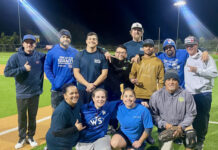Avalon’s falconry program has apparently caused the city’s feathered pests to see friendlier skies.
Last October, the City Council approved a contract with On The Wing falconry service to use predator birds to discourage troublesome birds from loitering in Avalon.
“It’s going well,” said City Manager Steve Hoefs.
While unique, the program is not a new idea. Airports and wineries have been known to hire falconers to drive off unwanted birds.
Avalon’s falconry program has apparently caused the city’s feathered pests to see friendlier skies.
Last October, the City Council approved a contract with On The Wing falconry service to use predator birds to discourage troublesome birds from loitering in Avalon.
“It’s going well,” said City Manager Steve Hoefs.
While unique, the program is not a new idea. Airports and wineries have been known to hire falconers to drive off unwanted birds.
Hoefs said it appears the local populations of pigeons and seagulls—Catalina’s pest birds—have been significantly reduced by Avalon’s falconry program.
Hoefs didn’t have exact figures. “How many (pest birds) were here before is anybody’s guess,” he said.
For example, a group of pigeons used to loiter under the pier. Hoefs said they have been pretty much eliminated.
No, they haven’t been killed. The raptor birds used by On The Wing come to the Island three or four days a week to frighten off pest birds without physically harming them.
Not all the birds in the program are falcons. One of the recent members of the On the Wing flock is an owl named Al who appeared in a recent issue of the Islander.
Unfortunately, a group of ravens killed a baby falcon last year while it was being trained.
“The raptors are specifically trained such that they will not make physical contact, kill or otherwise harm the nuisance birds,” wrote City Attorney Scott Campbell in an October report to the City Council.
At the time, Campbell’s report said that nuisance birds such as pigeons and western gulls forage for food in town and their waste contributes to unsanitary conditions, especially on the beaches.
“The continued concentration of nuisance birds will result in on-going adverse environmental impacts and will limit the recreational uses available to the city’s residents at parks and beaches,” Campbell wrote.
In late October, Hoefs told the Islander that readings had shown a direct correlation between seagull droppings and water quality in Avalon Bay.
This week, Hoefs said the program may help to improve Avalon’s water quality. He said the county would resume testing local waters around Easter week.
Hoefs expects the falconry program to continue through the summer.
“We’re hoping to run the program longer,” Hoefs said.
To that end, the city is planning to set up a falconry adventure that would allow about 10 people at a time to watch the training and flights of the raptor birds.
“That will help the city of Avalon pay for the program,” Hoefs said. Hoefs wants to maintain the program so the pest birds don’t return.
“There are about 700 falconers in California (of 7,000 nationwide) and we are the only falconry support group that exists for California,” according to the California Hawking Club website.










